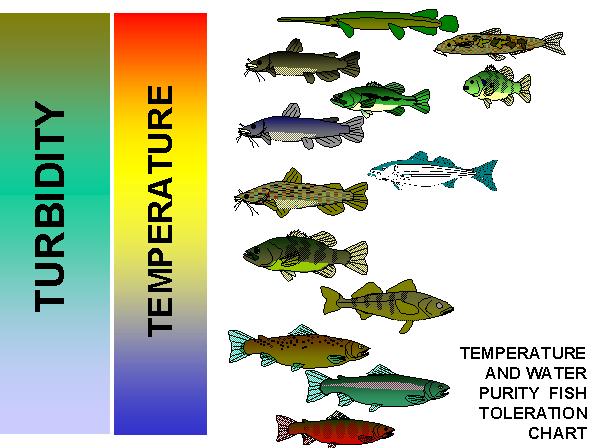









Nav:HOME ---- Fish Biology and Ecology ---- Ecology of a stream for anglers- A tale of balance (YOU ARE HERE)
Latest Reports |
Fishing Articles |
Fishing Tactics |
Fish Ecology and Biology |
Travel Articles |
Fishy Fun |
External Links |
Shopping |
HOME
The Ecology of
a Stream: A Tale of Balance
See also my Ozark Stream Ecology paper.
TEMEPERATURE AND
TURBIDITY
A stream is a continuously moving system, whose health is determined by
it's balance. This balance also determines which fish species will
be present in the stream, and what they eat (that is-what can an angler
catch them with). Essentially the biggest factors in determining
what kinds of fish are in a stream are the streams temperature, size, and
turbidity (how muddy it is). Every type of fish has a preferred temperature/turbidity
range (which also determines how much oxygen is dissolved in the
water), and a maximum temperature turbidity range. See the picture
below.

Clear, swift, cool streams usually host Salmonids (trout, whitefish,
graylings, salmon). Slightly slower, warmer, streams host perches
(walleye, yellow perch), smallmouth bass, and pikes (pickeral, pike, muskellunge).
Even warmer, slower streams hold catfish, largemouth bass, freshwater drums,
and temperate basses (stripers, white bass, yellow bass). Sluggish,
slow, muddy streams, like the lower Mississippi River hold largely largemouth
bass, sunfish, catfish, drum, carps, bowfins, and gars.
Back to top
THE ENERGY BALANCE
Erosion from deforestation, or runnoff from farms and lawns (which carry
fertilizers and manure) can turn a naturally cold, clear stream into a
cloudy, warm stream, and drastically shift what types of fish will prosper
in the stream (This is similar to what has happened to the Columbia River
in Oregon). Likewise, the construction of a dam, with its cold water
outflow, may turn a warm water system into a cold water one (the White
river in Arkansas). The life in a stream is a balance of plant life,
small insects/molluscs/and crustaceans, and fish: like a three-legged stool.
An increase in available light or fertilizer will tilt the three way balance
in favor of the plants, while stocking efforts will tilt the balance in
favor of the fish. Bottom line, the middle leg of the small insects/crustaceans/and
molluscs will determine the health of the stream, and therefore how many
naturally occuring fish will be present. Too many plants will choak
out the middle leg and the fish will starve. Too many fish and the
middle leg will be depleated-making all the fish starve and die.
A good stream has a healthy balance on all three legs. This picture might
help a little.

Back to the Top
THE WATER BALANCE
The amount of water in a stream will also effect how well fish do in
it. An increase in water volume will cool the stream off, while a
decrease in water flow will warm it up, shifting the temperature and turbidity
(and which fish are present). An example of this is the Sacremento
River in California, where irrigation will at times cause the river stand
still, hurting the salmon which spawn in the river, and causing saltwater
to creep into the river.

Back to Top
HOW DOES ALL OF THIS
EFFECT THE FOOD CHAIN?
(and what fish eat!)
The food web for a stream/river has essentially 6 teirs (each teir
mainly eats the one below it, and maybe two below it-teir 5 may eat from
teirs 4 and 3). Teir 0 is the sun, which only the plants and phytoplankton
(i.e. microscopic plants like algae) get energy from. Teir 1 are
plants and phytoplankton, Teir 2 are Zooplankton (microscopic animals),
Teir 3 are small visible animals-usually freshwater shrimp, freshly hatched
fish, small aquatic insects and terrestrial insects and worms that feed
in the stream. Teir 4 consists of fingerling juvenille fishes, small
true minnows (such as shiners and chubs), larger crustaceans (crayfish,
large shrimps), salamanders, molluscs (clams/mussells), and large predatory
aquatic insects (hellgramites, dragonfly larvae). Teir 5 is the layer
where most gamefish reside, and the most important to anglers (who, by
the way, are on Teir 6). Knowing what animals are on Teir 3 and 4 will
help the angler pick lures and baits appropriate for each stream.
Note, the illustrations below are just examples, since every stream has
variations that make fishing interesting! If you are lucky
enough to fish where there are fish on Teir 6 (like large Catfish, Sturgeon,
Large Salmon, Striped Bass, Large Pikes, and Alligator Gar), then remember
that these large predators are vital to the health of the river they live
in, and use judgement when keeping one. Take a peek at the pictures
below (cold, mid-warm, and warm) which can all exist on one river (here
the Merrimac River (just remove the brookies and salmon) in Missouri),
and use them to construct your own mental picture of each stream you fish.
Back to Top
UPPER RIVER -COLD WATER STREAM
SYSTEM

Back to Top
MID RIVER- COOL WATER RIVER

Back to Top
LOWER RIVER - WARM RIVER

Back to Top
Back to Top
LEGAL: ALL content ©1993-2015 Bryce L. Meyer. The term "Combat-Fishing" is a federally registered trademark. The camo fish and pole is a trademark. "Combat Fishing" when used in reference to travel information on the web or book, fishing websites, books, or sim is also a trademark.















